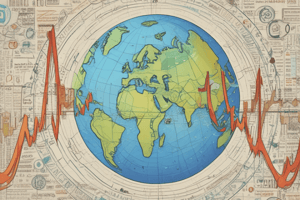Podcast
Questions and Answers
What characterizes the expansion stage of the business cycle?
What characterizes the expansion stage of the business cycle?
- Stagnant output and demand for labor
- Reduction in businesses' operations
- Recovery in economic indicators like unemployment rate and industrial production (correct)
- Decrease in economic activity and employment levels
What are some indicators of the peak stage of the business cycle?
What are some indicators of the peak stage of the business cycle?
- Decline in GDP growth and low interest rates
- Rapid expansion of businesses' operations
- Increase in employment levels
- Stagnation in economic activity and rising interest rates (correct)
Which phase of the business cycle marks the maximum potential of economic activity?
Which phase of the business cycle marks the maximum potential of economic activity?
- Trough stage
- Expansion stage
- Recession stage
- Peak stage (correct)
What could be a cause of a trough in the business cycle?
What could be a cause of a trough in the business cycle?
Which stage of the business cycle is likely to follow a recession?
Which stage of the business cycle is likely to follow a recession?
What is a common effect of the expansion stage on businesses?
What is a common effect of the expansion stage on businesses?
What characterizes the recession stage of the business cycle?
What characterizes the recession stage of the business cycle?
Which indicator can signal that the worst of the economic downturn has passed?
Which indicator can signal that the worst of the economic downturn has passed?
What does a consistent increase in retail sales typically indicate?
What does a consistent increase in retail sales typically indicate?
Which factor contributes to business cycles according to the text?
Which factor contributes to business cycles according to the text?
What does declining industrial production signify?
What does declining industrial production signify?
What do increasing interest rates often signal?
What do increasing interest rates often signal?
Flashcards are hidden until you start studying
Study Notes
Economics Business Cycle
Economics refers to the production, consumption, exchange, and distribution of goods and services within an economy. Business cycles are fluctuations in the economic condition of an economy over time, primarily characterized by expansions and contractions. The business cycle can be broken down into five stages: expansion, peak, recession, trough, and recovery. This article will explore each stage and provide some indicators that can signal these shifts in the business cycle.
Expansion Stage
The first phase of the business cycle, known as the expansion stage, is characterized by increases in both economic activity and employment levels. This period often begins after a significant downturn such as a recession, and it's marked by a recovery in various economic indicators like the unemployment rate, retail sales, and industrial production. During this stage, businesses expand their operations, leading to increased output and demand for labor.
Peak Stage
The peak of the business cycle marks the end of the expansion phase and the beginning of contraction. At this point, economic activity has reached its maximum potential, but there are signs that the economy may be slowing down. The peak can be identified through various indicators such as when Gross Domestic Product (GDP) growth begins to stagnate, interest rates rise, and employment levels start to decline slightly.
Recession Stage
After the peak, the economy enters into a recessionary phase characterized by declining economic activity, rising unemployment, and falling industrial production. This period commonly lasts from several months to over two years. The causes of recessions can vary, with common factors including changes in consumer confidence, financial instability, or government policy actions. Some key indicators during a recession include negative GDP growth, increasing unemployment figures, and shrinking industrial production.
Trough Stage
As the economy contracts further, it eventually reaches a trough – the lowest point of a recession. This is where economic activity hits rock bottom before starting to recover again. Significant decreases in inflation, unemployment, and other macroeconomic indicators are often present at the trough. It serves as a signal that the worst of the economic downturn has passed, and a new recovery phase may be on the horizon.
Indicators
Various indicators can help identify each stage of the business cycle:
- Unemployment Rate: High unemployment typically indicates a recession, while low unemployment usually signifies an expansion stage.
- Retail Sales: A consistent increase in retail sales can indicate an upward trend towards a peak, whereas a decrease can suggest the start of a recessionary phase.
- Interest Rates: Increasing interest rates often signal the transition from expansion to peak, while lowering interest rates can indicate either a move from recession to trough or recovery to peak.
- Industrial Production: Declining industrial production indicates a recessionary phase, while increasing production can signify an expansionary one.
Causes of Business Cycles
The causes of business cycles are complex and multifaceted, with several factors contributing to their occurrence. Some key contributors include changes in consumer confidence, financial instability, government policy actions, technological advancements, and shifts in global trade patterns. For example, during the late stages of World War II, many economies faced inflation due to demand being stronger than supply - this was a significant factor behind the post-war recovery experienced in countries like Japan and Germany. Understanding these underlying factors helps policymakers respond effectively to mitigate potential negative consequences associated with each stage of the business cycle.
Studying That Suits You
Use AI to generate personalized quizzes and flashcards to suit your learning preferences.



